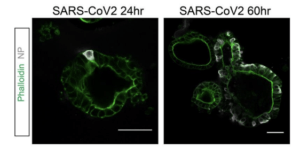
Immunofluorescent staining of SARS-CoV-2-infected intestinal organoids. Nucleoprotein (NP) stains viral capsid. After 24 hours, single virus-infected cells are generally observed in organoids. These small infection clusters spread through the whole organoid after 60 hours. (Source: Lamers et al., 2020)
It has been well described how SARS-CoV-2 infects lung tissue and causes severe acute respiratory syndrome, but now there is evidence to emerge that the intestine may also be involved as a viral target. It is also known the SARS-CoV-2 receptor, ACE2 (angiotensin converting enzyme 2), is expressed on differentiated enterocytes. In the May 1 2020 edition of Science, Lamers et al show, using human small intestinal organoids (hSIOs), that enterocytes could be infected by SARS-CoV and SARS-CoV-2 and that significant titers of infectious viral particles could be detected in these cells. When the authors performed mRNA sequence analysis after viral infection of the hSIOs they identified a broad signature of cytokines and interferon stimulated genes (ISGs) attributed to type I and III interferon responses. The authors conclude that “intestinal epithelium supports SARS-CoV-2 replication, and hSIOs serve as an experimental model for coronavirus infection and biology”.
Journal Article: Lamers et al., 2020. SARS-CoV-2 productively infects human gut enterocytes. Science
Article by Clive Gray
Also Read: Faecal shedding of SARS-CoV-2 by Kenneth Omollo










